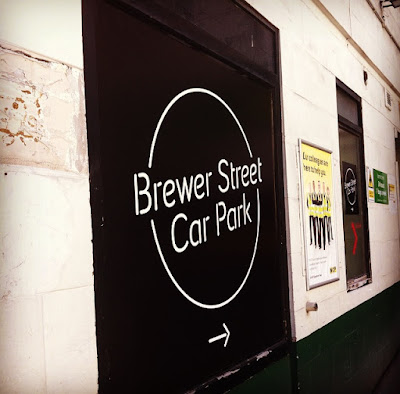Sarah Moor visits Ryoji Ikeda's Supersymmetry at Brewer Street Car Park and finds it just a touch overwhelming.
Japanese electronic
composer and visual artist Ryoji Ikeda first came onto my radar last summer
thanks to Spectra,
his light and sound installation which lit up Victoria Tower Gardens in August.
Spectra bore some resemblance to the United Visual
Artists Barbican exhibition Momentum of the same year,
which used pendulums to choreograph light, sound and movement, distorting
the visitors' experience of space. Similarly Umbrellium,
part of last years Digital
Revolution exhibition at the Barbican, allowed participants
to shape, manipulate and interact with luminous forms. Preceding the
examples above, the 2013 Light Show at
the Hayward Gallery showcased the experiential and phenomenal
aspects of light like never before, remaining to date one of my
favourite exhibitions.
The power of light and
sound to create atmosphere and shape spaces is clearly not new – it dates back
to the 1960s in fact – however Ikeda brings
the immersive, sensory experience to the public in unusual ways.
 |
| Spectra, August 4th-11th 2014 |
This is in part due to the removal of his
work from the traditional gallery space. Spectra used rays of light to
illuminate the floating particles and insects filling the summer evening air
surrounding an iconic London landmark. It created an otherworldly, almost
transcendental atmosphere and a sense of peacefulness, whilst allowing visitors
to interact with the beams and create their own sounds. His latest show
Supersymmetry uses the disorientating black space of The Vinyl Factory’s Brewer Street Car Park to stimulate
the senses in a much more intense way, paralysing the eye by the use of strobe
lights and using high-frequency sound to destabilise conscious
perception.
As you move through the darkened space, you
are drawn towards tables containing moving ball-bearings, which travel
organically like a flock of birds or swarm of bees across the top. At
times your eye follows a stray, solitary ballbearing which breaks free from the
pack only to collide back together with it moments later, regrouping to form
new shapes. The flash of strobe lights provide snapshots of their journey, and
the scanner-like quality of the table-top makes it clear that the
life of the ball bearings is being examined. The balls are alive, as though
part of a chemical, biological make-up.
As they moved across the body of the table
my mind imagined they were chemicals in the blood stream. A flash of the strobe
light later and the swooshing sounds of their movement transformed them into a mass of water, a wave which breaks up and disperses as it
crashes against the perimeters of the table. The simple action becomes so absorbing that it verges on the hypnotic, creating a sort of peace amidst the chaos of the movement, the noise and the
flashes of light.
A second room awaits, with two giant screens
lining the length of the room, and smaller screens placed in front; not a
million miles away from the NASA control room in Michael Bay’s Armageddon. The
data is continuously changing, the screens display information rich with modern day associations: a computer screensaver, a timeline accompanied by
typewriter sounds, random digital stats to the sound of white noise, lists of
gobbledygook accompanied by an overhead robotic voice, a hospital heart monitor
with the electrocardiogram line of life and familiar periodic beeps.
The crescendo of lines
and dots of data, along with the continuous static sound of electricity create
the feeling that the machines might explode with information at any moment. The seemingly
ungoverned recording and data gathering taking place is suggestive of a robot
out of control, and the rapid switch from screen to screen is almost unbearable
to watch. This room captures the pace of the never ending stream of information generated by the data-driven modern world; sound and vision are engaged by the
electric atmosphere in which the data of life is open for analysis.
Afterwards, I read the exhibition synopsis, ‘an artistic vision of the reality of nature, an interpretation of quantum
mechanics and quantum information theory from an aesthetic viewpoint’. To
me, Supersymmetry is the factual counterpart to the spiritual experience of
Spectra. Here, the emphasis is on data and the natural
flux of life, symbolised through digital means. I read the feedback book as I
left the exhibition, and one comment stood out: ‘it’s hard to be overwhelmed
these days but today I was’. I had to agree.
Sarah Moor





No comments:
Post a Comment